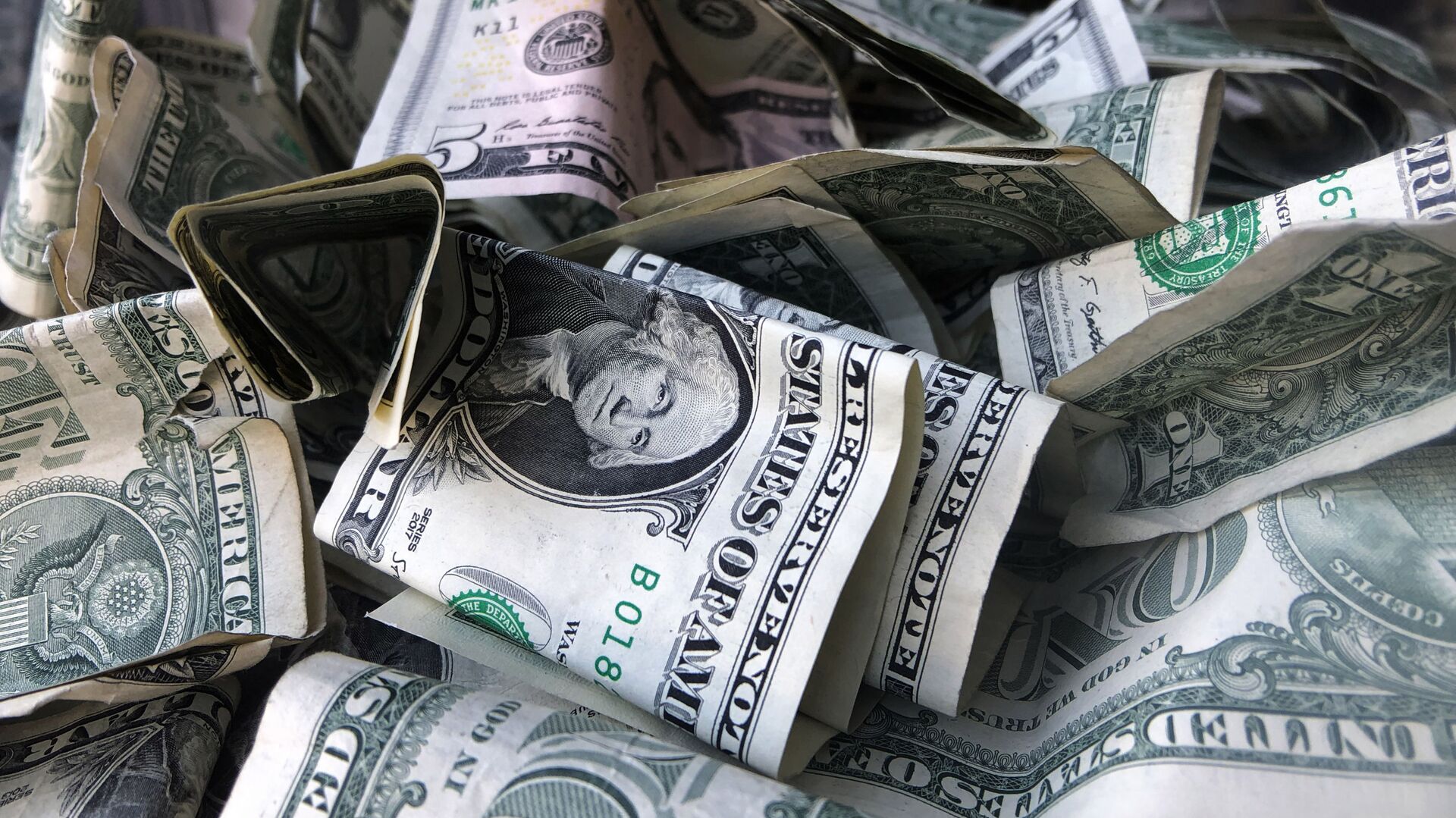https://sputniknews.in/20230207/toppling-dollar-hegemony-india-may-lead-by-example-in-global-south-783331.html
Toppling Dollar Hegemony? India May Lead by Example in Global South
Toppling Dollar Hegemony? India May Lead by Example in Global South
Sputnik India
Last year, New Delhi amended its foreign trade policy to allow international trade to be paid in the national currency. The mechanism is designed to help Indian businesses trade with Russia without the threat of US sanctions.
2023-02-07T19:23+0530
2023-02-07T19:23+0530
2023-05-16T00:18+0530
india
russia
russian oil price cap
russian oil
rupee-rouble trade
trade in national currencies
dedollarisation
business & economy
https://cdn1.img.sputniknews.in/img/07e7/02/07/788501_0:165:3055:1883_1920x0_80_0_0_e65c8053cc98201fa5541a370592183d.jpg
In January, media reports suggested that India is now working with the United Arab Emirates (UAE) on setting up a rupee-dirham payment mechanism.Last year, in December, India saw its first settlement of foreign trade in rupees with Russia.What is Behind De-Dollarization Drive?Not only Russia and the UAE, but a whole array of South Asian nations, like Bangladesh and Sri Lanka and African states such as Tanzania, have reportedly expressed their desire to settle bilateral trade with India in national currencies.This came after India’s Central Bank, the Reserve Bank of India (RBI), initiated the "International Settlement of Trade in Indian Rupee" mechanism last July.India’s decision to be paid in national currencies came amid geopolitical and economic tension, as the US restricted trade with Russia and Iran in the dollar. The move was also made with the hope that it would promote the growth of global trade with an emphasis on Indian exports and increase the interest of other countries in the rupee.Sputnik spoke with Dr. Anuradha Chenoy, professor at the Center for Russian and Central Asian Studies at Jawaharlal Nehru University, Delhi, who said that India uses up to $ 4 billion in forex a month to purchase oil, which is a burden on its strategic reserves. "Like many other countries, India has been searching for multiple payment methods. But these have not been fructified."Beginning of Long-Term JourneyDr. Chenoy said she is not surprised by media reports that Indian refiners have begun paying for much of their oil purchased via Dubai-based traders in UAE dirhams instead of US dollars.She said Saudi Arabia and the Gulf Cooperation Countries (GCC) now have reasons to sell their oil in multiple currencies to diversify sales and start new routes of payments. Dr. Chenoy opined that the GCC is thus also looking at diversifying their oil exports and payment methods, which could be in dirhams, yuan, or any stable currency.She also said that a single nation could not end dollar dependency, rather it needs many collaborators in the effort.Indian importers will make payments in rupees that will be credited to a Vostro account (special rupee accounts in Indian banks) of the corresponding bank of a partner country, while Indian exporters will be paid from the balances in the designated Vostro accounts.The balance in the Vostro accounts can be used for investments in government securities, and payments for bilateral trade. So far, Mauritius, Russia, Sri Lanka, the UAE, and Saudi Arabia have opened Vostro accounts. Many more central banks, such as those of Tajikistan, Cuba, Luxembourg, and Sudan, are talking about adopting the mechanism.High Exchange Rate of Dollar May Result in Debt Trap for Developing NationsDr. Chenoy stated that it is no secret that India, like many other countries, has to bear the burden of using dollars to buy oil because of international constraints that have tied the dollar to oil purchases since the 1970s. "The high exchange rate of the dollar and the falling dollar reserves and indebtedness is one of the factors that lead countries of the South to debt traps." She stressed the fact that India is making an effort to shift to rupee-based and national currency trade systems gradually, and if everything goes smoothly, India may emerge as a good example for the Global South.Could Non-Dollar Trade Become a Broader Trend for Indian Refiners?Another expert, Suranjali Tandon, assistant professor at the Delhi-based National Institute of Public Finance and Policy, told Sputnik that in wake of Western sanctions, it is relatively advantageous for India to explore alternative payment mechanisms.She noted how previous attempts by Indian refiners to pay traders for Russian crude in dirhams through Dubai banks had failed, forcing them to switch back to the dollar. "Previously, Indian refiners are reported to have paid for Russian crude in Dirhams through Dubai banks and it failed. This could be for multiple reasons, one is that the use of the currency of another oil exporting country for settling the transactions with Russia can possibly undermine the economic position of the UAE," Tandon explained."That is, a sudden demand for Dirhams to settle transactions can lead to appreciation of Dirhams, hurting the exports from Dubai. Two, it takes time for the financial system to accommodate for the spike in demand for currency. This can create scarcity of currency required for executing usual transactions. It is possible that these glitches have now been addressed," the expert concluded.
https://sputniknews.in/20230124/brics-working-to-boost-payments-in-national-currencies-as-dollar-unreliable-lavrov-625205.html
india
russia
Sputnik India
feedback.hindi@sputniknews.com
+74956456601
MIA „Rossiya Segodnya“
2023
Deexa Khanduri
https://cdn1.img.sputniknews.in/img/07e6/0c/13/138923_52:0:533:481_100x100_80_0_0_cadf23d341691fc65ff2b22fd1afe584.jpg
Deexa Khanduri
https://cdn1.img.sputniknews.in/img/07e6/0c/13/138923_52:0:533:481_100x100_80_0_0_cadf23d341691fc65ff2b22fd1afe584.jpg
News
en_IN
Sputnik India
feedback.hindi@sputniknews.com
+74956456601
MIA „Rossiya Segodnya“
Sputnik India
feedback.hindi@sputniknews.com
+74956456601
MIA „Rossiya Segodnya“
Deexa Khanduri
https://cdn1.img.sputniknews.in/img/07e6/0c/13/138923_52:0:533:481_100x100_80_0_0_cadf23d341691fc65ff2b22fd1afe584.jpg
new delhi, national currency, rupee, united arab emirates, rupee-dirham payment mechanism, foreign trade in rupee, international settlement of trade in indian rupee, dollar hegemony,
new delhi, national currency, rupee, united arab emirates, rupee-dirham payment mechanism, foreign trade in rupee, international settlement of trade in indian rupee, dollar hegemony,
Toppling Dollar Hegemony? India May Lead by Example in Global South
19:23 07.02.2023 (Updated: 00:18 16.05.2023) Deexa Khanduri
Sputnik correspondent
Last year, New Delhi amended its foreign trade policy to allow international trade payments in the national currency. This is intended to help Indian businesses trade with Russia, avoiding US sanctions.
In January, media reports suggested that India is now working with the United Arab Emirates (UAE) on setting up a rupee-dirham payment mechanism.
Last year, in December, India saw its first settlement of foreign trade in rupees with Russia.
What is Behind De-Dollarization Drive?
Not only Russia and the UAE, but a whole array of South Asian nations, like Bangladesh and Sri Lanka and African states such as Tanzania, have reportedly expressed their desire to settle bilateral trade with India in national currencies.
This came after India’s Central Bank, the Reserve Bank of India (RBI), initiated the "International Settlement of Trade in Indian Rupee" mechanism last July.
India’s decision to be paid in national currencies came amid geopolitical and economic tension, as the US restricted trade with Russia and Iran in the dollar. The move was also made with the hope that it would promote the growth of global trade with an emphasis on Indian exports and increase the interest of other countries in the rupee.
Sputnik spoke with Dr. Anuradha Chenoy, professor at the Center for Russian and Central Asian Studies at Jawaharlal Nehru University, Delhi, who said that India uses up to $ 4 billion in forex a month to purchase oil, which is a burden on its strategic reserves. "Like many other countries, India has been searching for multiple payment methods. But these have not been fructified."
"The sanctions on Russia force India to be cautious even though India would like to use the rupee-ruble route for payments,” she stated.
Beginning of Long-Term Journey
Dr. Chenoy said she is not surprised by media reports that Indian refiners have begun paying for much of their oil purchased via Dubai-based traders in UAE dirhams instead of US dollars.
She said Saudi Arabia and the Gulf Cooperation Countries (GCC) now have reasons to sell their oil in multiple currencies to diversify sales and start new routes of payments.
"The imposition by the US of price caps that payments should not exceed $60/bbl for Russian crude has not gone down well with oil exporting countries because the US can apply similar rules against them when its geopolitical interests direct."
Dr. Chenoy opined that the GCC is thus also looking at diversifying their oil exports and payment methods, which could be in dirhams, yuan, or any stable currency.
She also said that a single nation could not end dollar dependency, rather it needs many collaborators in the effort.
“This is a long and detailed process that has begun. India, along with BRICS, initiated payments in local currencies for trade and has supported the New Development Bank (created by the BRICS) that disburses 50% of its loans in national currencies,” she explained.
Indian importers will make payments in rupees that will be credited to a Vostro account (special rupee accounts in Indian banks) of the corresponding bank of a partner country, while Indian exporters will be paid from the balances in the designated Vostro accounts.
The balance in the Vostro accounts can be used for investments in government securities, and payments for bilateral trade. So far, Mauritius, Russia, Sri Lanka, the UAE, and Saudi Arabia have opened Vostro accounts.
Many more central banks, such as those of Tajikistan, Cuba, Luxembourg, and Sudan, are talking about adopting the mechanism.
High Exchange Rate of Dollar May Result in Debt Trap for Developing Nations
Dr. Chenoy stated that it is no secret that India, like many other countries, has to bear the burden of using dollars to buy oil because of international constraints that have tied the dollar to oil purchases since the 1970s. "The high exchange rate of the dollar and the falling dollar reserves and indebtedness is one of the factors that lead countries of the South to debt traps."
She stressed the fact that India is making an effort to shift to rupee-based and national currency trade systems gradually, and if everything goes smoothly, India may emerge as a good example for the Global South.
“Further, it appears that the Gulf countries share a similar enthusiasm. If this works smoothly, it will encourage such payments instead of the dollar. This benefits The Gulf oil exporting countries, India as well is a good example for the global South,” she added.
Could Non-Dollar Trade Become a Broader Trend for Indian Refiners?
Another expert, Suranjali Tandon, assistant professor at the Delhi-based National Institute of Public Finance and Policy, told Sputnik that in wake of Western sanctions, it is relatively advantageous for India to explore alternative payment mechanisms.
"The current trends point to the gradual shift away from dollars. That is, as more and more transactions are executed in currencies other than dollars, as sanctions continue, it is possible that it becomes a general practice. However, this will depend largely on the extent to which Indian refiners purchase oil from countries willing to transact in currencies other than dollars," Tandon says.
She noted how previous attempts by Indian refiners to pay traders for Russian crude in dirhams through Dubai banks had failed, forcing them to switch back to the dollar.
"Previously, Indian refiners are reported to have paid for Russian crude in Dirhams through Dubai banks and it failed. This could be for multiple reasons, one is that the use of the currency of another oil exporting country for settling the transactions with Russia can possibly undermine the economic position of the UAE," Tandon explained.
"That is, a sudden demand for Dirhams to settle transactions can lead to appreciation of Dirhams, hurting the exports from Dubai. Two, it takes time for the financial system to accommodate for the spike in demand for currency. This can create scarcity of currency required for executing usual transactions. It is possible that these glitches have now been addressed," the expert concluded.



